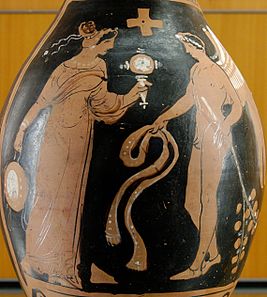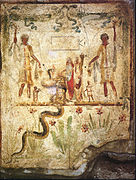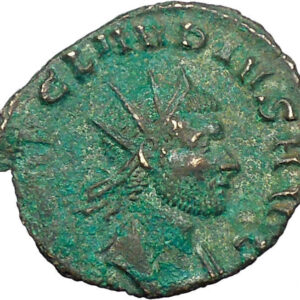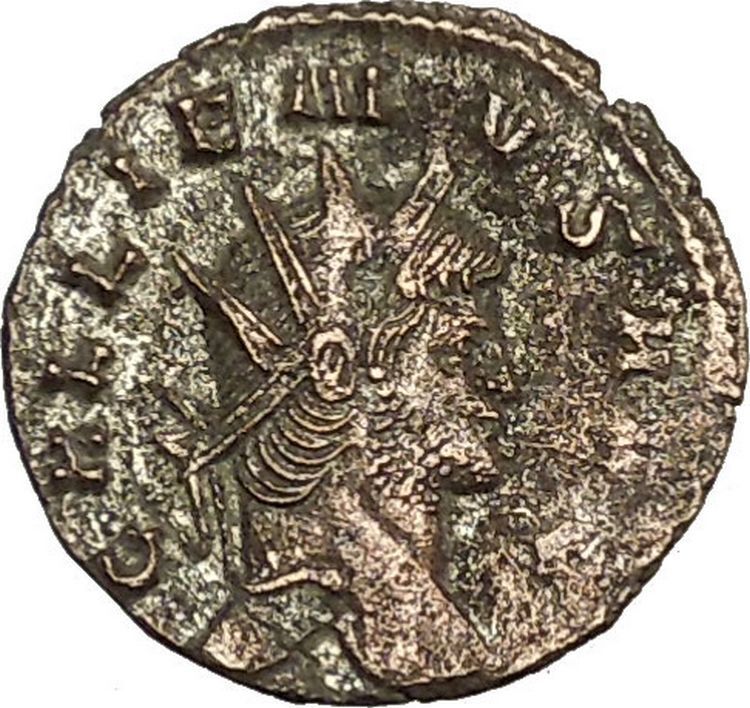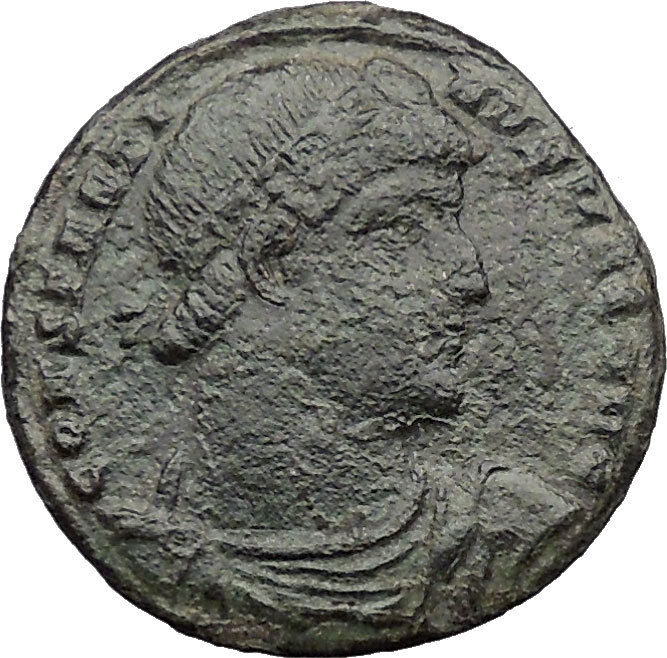Modern-era
|
|
Claudius II (Latin:
Marcus Aurelius Valerius Claudius Augustus;
May 10, 213 – January 270), commonly known as Claudius Gothicus, was
Roman Emperor
from 268 to 270. During his reign
he fought successfully against the
Alamanni
and scored a crushing victory against
the Goths
at the
Battle of Naissus
. He died after succumbing to
a
plague (perhaps smallpox)
that ravaged the
provinces of the Empire.
Life
Origin and rise to
power
Claudius’ origin is uncertain. Born on May 10, 213, he was either from
Sirmium
in
Pannonia Inferior
or from
Naissus
Dardania
(in
Moesia Superior
).
Claudius had served with the Roman army for all his adult life, making his
way up the military hierarchy until the Emperor
Gallienus
made him the commander of his elite
cavalry
force (hipparchos) and subsequently his
military deputy.In September 268 he found himself assigned as a military tribune
with the Imperial Army besieging the usurper
Aureolus
in
Milan
. His troops then proclaimed him Emperor
amid charges, never proven, that he murdered his predecessor
Gallienus
. However, he soon proved to be less
than bloodthirsty, as he asked the
Roman Senate
to spare the lives of
Gallienus
‘ family and supporters. He was less
magnanimous toward Rome’s enemies, however, and it was to this that he owed his
popularity.It is possible Claudius gained his position and the respect of the
soldiers by being physically strong and especially cruel. A legend tells of
Claudius knocking out a horse’s teeth with one punch. When Claudius performed as
a wrestler in the 250s, he supposedly knocked out the teeth of his opponent when
his genitalia had been grabbed in the match.
Claudius, like
Maximinus Thrax
before him, was of
barbarian
birth. After an interlude of failed
aristocratic
Roman emperors since Maximinus’
death, Claudius was the first in a series of tough soldier-emperors who would
eventually restore the Empire from the
Crisis of the third century
.
The Downfall of
Gallienus

Antoninianus
of Claudius II
During the 260s, the breakup of the
Roman Empire
into three distinct governing
entities (the core Roman Empire, the
Gallic Empire
and the
Palmyrene Empire
) placed the whole Roman
imperium into a precarious position.
Gallienus
was seriously weakened by his failure
to defeat Postumus
in the West, and the ability of
Odaenathus
to live with his arrangement with
Gallienus in the East. By 268, however, the situation had changed, as
Odaenathus
was put to death, most likely out of
court intrigue, and Gallienus fell victim to a mutiny in his own ranks. Upon the
death of Odaenathus, power fell to his younger son, who was dominated by his
mother, Zenobia
.
Under threat of invasion by multiple tribes, Gallienus’ troubles primarily
lay with Postumus
, whom he could not attack because his
attention was required in dealing with
Macrianus
and the invading “Skythai.” After
four years of delay, Postumus had established power, but in 265, when Gallienus
and his men crossed the Alps, they defeated and besieged
Postumus
in an (unnamed)
Gallic
city. When victory appeared to be near,
Gallienus made the mistake of approaching the city walls too closely and was
gravely injured, compelling him to withdraw the campaign. In the next three
years, Gallienus’ troubles would only get worse. The “Skythai” successfully
invaded the Balkans
in the early months of 268, and
Aureolus
, a commander of the cavalry, declared
himself an ally of Postumus and the new emperor in
Milan
.
At this time, another invasion was taking place. A group called the Herulians
navigated through
Asia Minor
and then into
Greece
on a naval expedition. Details of these
invasions are abstract, as it is nearly impossible to reconstruct the
happenings, due to the chain of conflicts initiated by the Herulians in 268.
Scholars assume Gallienus’ efforts were focused on Aureolus, the officer who
betrayed him, and the defeat of the Herulians was left to his successor,
Claudius Gothicus.
The death of Gallienus is surrounded by conspiracy and betrayal, as were many
emperors’ deaths. Different accounts of the incident are recorded, but they
agree that senior officials wanted Gallienus dead. According to two accounts,
the prime conspirator was
Heraclianus
. One version of the story tells of
Heraclianus bringing Claudius into the plot while the account given by
Historia Augusta
exculpates the would-be
emperor and adds the prominent general
Marcianus
into the plot. The removal of
Claudius from the conspiracy is due to his later role as the progenitor of the
house of
Constantine
, a fiction of
Constantine
‘s time, and may serve to guarantee
that the original version from which these two accounts spring was current prior
to the reign of Constantine. It is written that while sitting down at dinner,
Gallienus was told that Aureolus and his men were approaching the camp.
Gallienus rushed to the front lines, ready to give orders, when he was struck
down by a commander of his cavalry. In a different and more controversial
account, Aureolus forges a document in which Gallienus appears to be plotting
against his generals and makes sure it falls into the hands of the emperor’s
senior staff. In this plot,
Aurelian
is added as a possible conspirator.
The tale of his involvement in the conspiracy might be seen as at least partial
justification for the murder of Aurelian himself under circumstances that seem
remarkably similar to those in this story.Whichever story is true, Gallienus was
killed in the summer of 268, and
Marcus Aurelius Claudius
was chosen by the army
outside of Milan
to succeed him. Accounts tell of people
hearing the news of the new Emperor, and reacting by murdering Gallienus’ family
members until Claudius declared he would respect the memory of his predecessor.
Claudius had the deceased emperor deified and buried in a family tomb on the
Appian Way
. The traitor
Aureolus
was not treated with the same
reverence, as he was killed by his besiegers after a failed attempt to
surrender.
The Campaigns of
Claudius
At the time of his Claudius’ accession, the
Roman Empire
was in serious danger from several
incursions, both within and outside its borders. The most pressing of these was
an invasion of
Illyricum
and
Pannonia
by the
Goths
.[18]
Although Gallienus
had already inflicted some damage on
them at the Battle of Nestus, Claudius, not long after being named Emperor,
followed this up by winning his greatest victory, and one of the greatest in the
history of Roman arms.

The Roman Empire in 268 A.D
At the
Battle of Naissus
, Claudius and his legions
routed a huge Gothic army. Together with his
cavalry
commander, the future Emperor
Aurelian
, the Romans took thousands of
prisoners, destroyed the Gothic cavalry as a force, and stormed their
laager
(a circular alignment of wagons long
favored by the Goths). The victory earned Claudius his surname of “Gothicus”
(conqueror of the Goths), and that is how he is known to this day. More
importantly, the Goths were soon driven back across the
Danube River
by Aurelian, and nearly a century
passed before they again posed a serious threat to the empire.
At the same time, the
Alamanni
had crossed the
Alps and attacked the empire. Claudius responded quickly, routing the
Alamanni at the
Battle of Lake Benacus
in the late fall of 268,
a few months after the battle of Naissus. For this he was awarded the title of “Germanicus
Maximus.” He then turned on the
Gallic Empire
, ruled by a pretender for the
past fifteen years and encompassing
Britain
,
Gaul, and the
Iberian Peninsula
. He won several victories and
soon regained control of Spain and the Rhone river valley of Gaul.This set the
stage for the ultimate destruction of the Gallic Empire under Aurelian.
However, Claudius did not live long enough to fulfill his goal of reuniting
all the lost territories of the empire. Late in 269 he had traveled to
Sirmium
and was preparing to go to war against
the Vandals
, who were raiding in
Pannonia
.[However,
he fell victim to the
Plague of Cyprian
(possibly
smallpox
), and died early in January 270.
Before his death, he is thought to have named Aurelian as his successor, though
Claudius’ brother
Quintillus
briefly seized power.The
Senate
immediately deified Claudius as “Divus
Claudius Gothicus”.The
Empire and Foreign Affairs Under Claudius
Claudius was not the only man to reap the benefits of holding high office
after the death of
Gallienus
. Before the rule of Claudius
Gothicus, there had only been two emperors from the
Balkans
, but afterwards there would only be one
emperor who did not hail from the provinces of
Pannonia
,
Moesia
or
Illyricum
until the year 378, when
Theodosius I
from
Hispania
would take the throne. To comprehend
the structure of government during the reign of Claudius, we must look at four
inscriptions that deepen our understanding of a new, truncated empire. The first
is a dedication to
Aurelius Heraclianus
, the prefect involved in
the conspiracy against Gallienus, from Traianus Mucianus, who also gave a
dedication to
Heraclianus
‘ brother, Aurelius Appollinaris,
who was the equestrian governor of the province of
Thracia
in 267-68 AD.Because these men shared
the family name, Marcus Aurelius, a name given to those made citizens by the
constitutio Antoniniana
, we can understand that
these men did not come from the imperial élite. The third inscription reveals
the career of
Marcianus
, another leading general by the time
that Gallienus died. The fourth honors Julius Placidianus, the prefect of the
vigiles
. While we cannot prove that
Heraclianus, Appollinaris,
Placidianus
, or Marcianus were of
Danubian
origin themselves, it is clear that
none of them were members of the
Severan
aristocracy, and all of them appear to
owe their prominence to their military roles. To these men must be added Marcus
Aurelius Aurelianus (the future emperor
Aurelian
) and
Marcus Aurelius Probus
(another emperor in
waiting), both men of Balkan background, and from families enfranchised in the
time of Caracalla
.
Although we see a rise in Pannonian, Moesian and Illyrian marshals, and
foreigners become notable figures, it would be impractical to think the
government could function without help from the traditional classes within the
empire. Although their influence was weakened, there were still a number of men
with influence from the older
aristocracy
. Claudius assumed the consulship in
269 with Paternus, a member of the prominent senatorial family, the Paterni, who
had supplied consuls and urban prefects throughout Gallienus’ reign, and thus
were quite influential. In addition,
Flavius Antiochianus
, one of the consuls of
270, who was an urban prefect the year before, would continue to hold his office
for the following year. A colleague of Antiochianus, Virius Orfitus, also the
descendant of a powerful family, would continue to hold influence during his
father’s term as prefect. Aurelian’s colleague as consul was another such man,
Pomponius Bassus, a member of one of the oldest senatorial families, as was one
of the consuls in 272, Junius Veldumnianus.
In his first full year of power, Claudius was greatly assisted by the sudden
destruction of the imperium Galliarum. When Ulpius Cornelius Laelianus, a high
official under Postumus
, declared himself emperor in
Germania Superior
, in the spring of 269,
Postumus
defeated him, but in doing so, refused
to allow the sack of Mainz
, which had served as
Laelianus
‘ headquarters. This proved to be his
downfall, for out of anger, Postumus’ army mutinied and murdered him. Selected
by the troops,
Marcus Aurelius Marius
was to replace Postumus
as ruler. Marius’ rule did not last long though, as
Victorinus
, Postumus’ praetorian prefect,
defeated him. Now emperor of the
Gauls, Victorinus was soon in a precarious position, for the Spanish
provinces had deserted the
Gallic Empire
and declared their loyalty to
Claudius, while in southern
France
,
Placidianus
had captured
Grenoble
. Luckily, it was there that
Placidianus stopped and Victorinus’ position stabilized. In the next year, when
Autun
revolted, declaring itself for Claudius,
the central government made no moves to support it. As a result, the city went
through a siege, lasting many weeks, until it was finally captured and sacked by
Victorinus.It is still unknown why Claudius did nothing to help the city of
Autun
, but sources tell us his relations with
Palmyra
were waning in the course of 270. An
obscure passage in the
Historia Augusta
life of Gallienus states that
he had sent an army under
Heraclianus
to the region that had been
annihilated by Zenobia
. But because Heraclianus was not
actually in the east in 268 (instead, at this time, he was involved in the
conspiracy of Gallienus’ death), we can see that this can not be correct. But
the confusion evident in this passage, which also places the bulk of “Skythian”
activity during 269 a year earlier, under Gallienus, may stem from a later
effort to pile all possible disasters in this year into the reign of the former
Emperor. This would keep Claudius’ record of being a descendant of
Constantine
from being tainted. If this
understanding of the sources is correct, it might also be correct to see the
expedition of Heraclianus to the east as an event of Claudius’ time.
The victories of Claudius over the
Goths
would not only make him a hero in
Latin
tradition, but an admirable choice as an
ancestor for
Constantine
, who was born at
Naissus
, the site of Claudius’ victory in 269.
Claudius is also held in high esteem by
Zonaras
, whose
Greek
tradition seems to have been influenced
by Latin
. For
Zosimus
, a more reasoned contemporary view
shows him as less grand. Claudius’ successes in the year 269 were not continued
in his next year as Emperor. As the “Skythai” starved in the mountains or
surrendered, the legions pursuing them began to see an epidemic spreading
throughout the men. Also, Claudius’ unwillingness to do anything at the siege of
Autun
likely provoked a quarrel with
Zenobia
.
Although it is not proven that the invasion of
Gaul was the breaking point between Claudius and Zenobia, the
sequence of events point to the siege as an important factor. The issue at hand
was the position that
Odaenathus
held as corrector totius orientis.
Vaballathus
, the son of Zenobia, was given this
title when Zenobia claimed it for him. From then on, tension between the two
empires would only get worse.
Heraclianus
‘ fabled arrival might have been an
effort to reassert central control after the death of Odaenathus, but, if so, it
failed. Although coins were never minted with the face of Odaenathus, soon after
his death coins were made with image of his son.
Under Zabdas
, a
Palmyrene
army invaded
Arabia
and moved into
Egypt
in the late summer. At this time, the
prefect of Egypt was Tenagino Probus, described as an able soldier who not only
defeated an invasion of
Cyrenaica
by the nomadic tribes to the south in
269, but also was successful in hunting down “Skythian” ships in the
Mediterranean
. However, he did not see the same
success in Egypt, for a Palmyrene underground, led by
Timagenes
, undermined
Probus
, defeated his army, and killed him in a
battle near the modern city of
Cairo
in the late summer of 270.
Generally when a Roman commander is slaughtered it is taken as a sign that a
state of war is in existence, and if we can associate the death of
Heraclianus
in 270, as well as an inscription
from
Bostra
recording the rebuilding of a temple
destroyed by the Palmyrene army, then these violent acts could be interpreted
the same way. Yet they apparently were not. As David Potter writes, “The coins
of Vaballathus
avoid claims to imperial power: he
remains vir consularis, rex, imperator, dux Romanorum, a range of titles that
did not mimic those of the central government. The status vir consularis was, as
we have seen, conferred upon
Odaenathus
; the title rex, or king, is simply a
Latin
translation of mlk, or king; imperator in
this context simply means “victorious general”; and dux Romanorum looks like yet
another version of corrector totius orientis” (Potter, 263). These titles
suggest that Odaenathus’ position, not unlike a king in the
Semitic
world, was inheritable. In Roman
culture, the status gained in procuring a position could be passed on, but not
the position itself. It is possible that the thin line between office and the
status that accompanied it were dismissed in Palmyrene court, especially when
the circumstance worked against the interests of a regime that was able to
defeat
Persia
, which a number of Roman emperors had
failed to do. Vaballathus stressed the meanings of titles, because in Palmyrene
context, the titles of Odaenathus meant a great deal. When the summer of 270
ended, things were looking very different in the empire than they did a year
before. After its success,
Gaul was in a state of inactivity and the empire was failing in the
east. Insufficient resources plagued the state, as a great deal of silver was
used for the
antoninianus
, which was again diluted.
Religion
An account written by Aurelius Victor states that Claudius consulted the
Sibylline Books
prior to his campaigns against
the Goths
. Hinting that Claudius “revived the
tradition of the Decii”, Victor illustrates the senatorial view, which saw
Claudius’ predecessor,
Gallienus
, as too relaxed when it came to
religious policies.
Links to
Constantinian dynasty
The unreliable
Historia Augusta
reports Claudius and
Quintillus having another brother named Crispus and through him a niece,
Claudia, who reportedly married Eutropius and was mother to
Constantius Chlorus
.Some historians suspect
this account to be a
genealogical
fabrication, however, intended to
link the family of
Constantine I
to that of a well-respected
emperor.
Saint Valentine
Claudius Gothicus has been linked to
Saint Valentine
since the
Middle Ages
. Contemporary records of his deeds
were most probably destroyed during the
Diocletianic Persecution
on early 4th century
and a tale of martydom was invented in Passio Marii et Marthae, a “fanciful”
work published in the 5th or 6th century. 20th-century historians agree that the
accounts from this period are not historically accurate.The legend refers to
“Emperor Claudius” but
Claudius I
did not make any persecution against
Christians, so people assigned him to be Claudius II even although this emperor
spent most of his time warring outside of his territory.Furthermore, there is no
evidence, outside of St. Valentine’s legends, for Claudius II reversing
Gallienus
‘s policy of toleration for
Christians.The legend was retold in later texts. In the
Nuremberg Chronicle
of 1493 AD, the emperor
martyred the Roman priest during a general persecution of Christians. The text
states that St. Valentine was beaten with clubs and finally beheaded for giving
aid to
Christians
in Rome.The
Golden Legend
of 1260 AD recounts how St.
Valentine refused to deny Christ before the “Emperor Claudius” in 270 AD and as
a result was beheaded. Since then, February 14 marks
Valentine’s Day
, a day set aside by the
Christian church in memory of the Roman priest and physician.
|
|
|
Frequently Asked d Questionss How long until my order is shipped?:: shipment of your order after the receipt of payment. How will I know when the order was shipped?: date should be used as a basis of estimating an arrival date. After you shipped the order, how long will the mail take? international shipping times cannot be estimated as they vary from country to country. I am not responsible for any USPS delivery delays, especially for an international package. What is a certificate of authenticity and what guarantees do you give that the item is authentic? and a Lifetime Guarantee of Authenticity, issued by a world-renowned numismatic and antique expert that has identified over 10000 ancient coins and has provided them with the same guarantee. You will be quite happy with what you get with the COA; a professional presentation of the coin, with all of the relevant information and a picture of the coin you saw in the listing. Compared to other certification companies, the certificate of authenticity is a $25-50 value. So buy a coin today and own a piece of history, guaranteed. Is there a money back guarantee? I offer a 30 day unconditional money back guarantee. I stand behind my coins and would be willing to exchange your order for either store credit towards other coins, or refund, minus shipping expenses, within 30 days from the receipt of your order. My goal is to have the returning customers for a lifetime, and I am so sure in my coins, their authenticity, numismatic value and beauty, I can offer such a guarantee. Is there a number I can call you with questions about my order?
You can contact me directly via ask seller a question and request my telephone number, or go to my About Me Page to get my contact information only in regards to items purchased on eBay. When should I leave feedback? order, please leave a positive. Please don’t leave any negative feedbacks, as it happens many times that people rush to leave feedback before letting sufficient time for the order to arrive. Also, if you sent an email, make sure to check for my reply in your messages before claiming that you didn’t receive a response. The matter of fact is that any issues can be resolved, as reputation is most important to me. My goal is to provide superior products and quality of service. |








